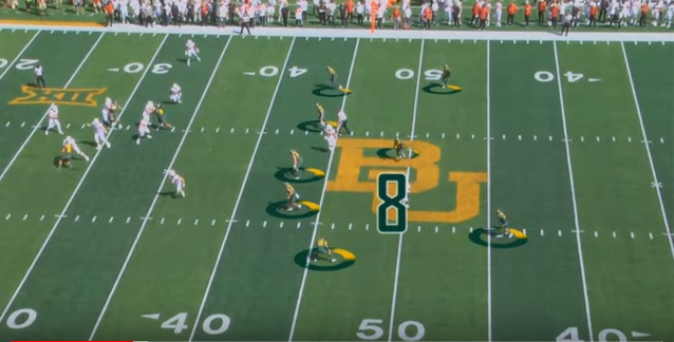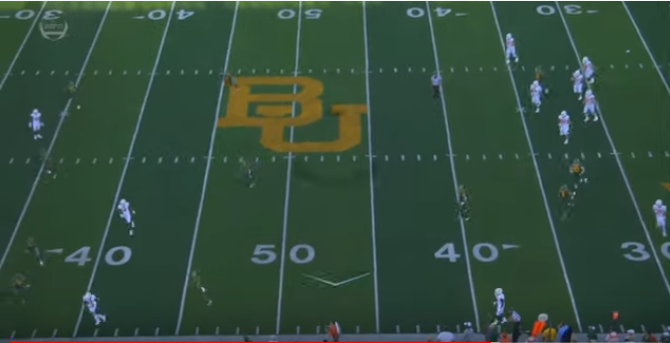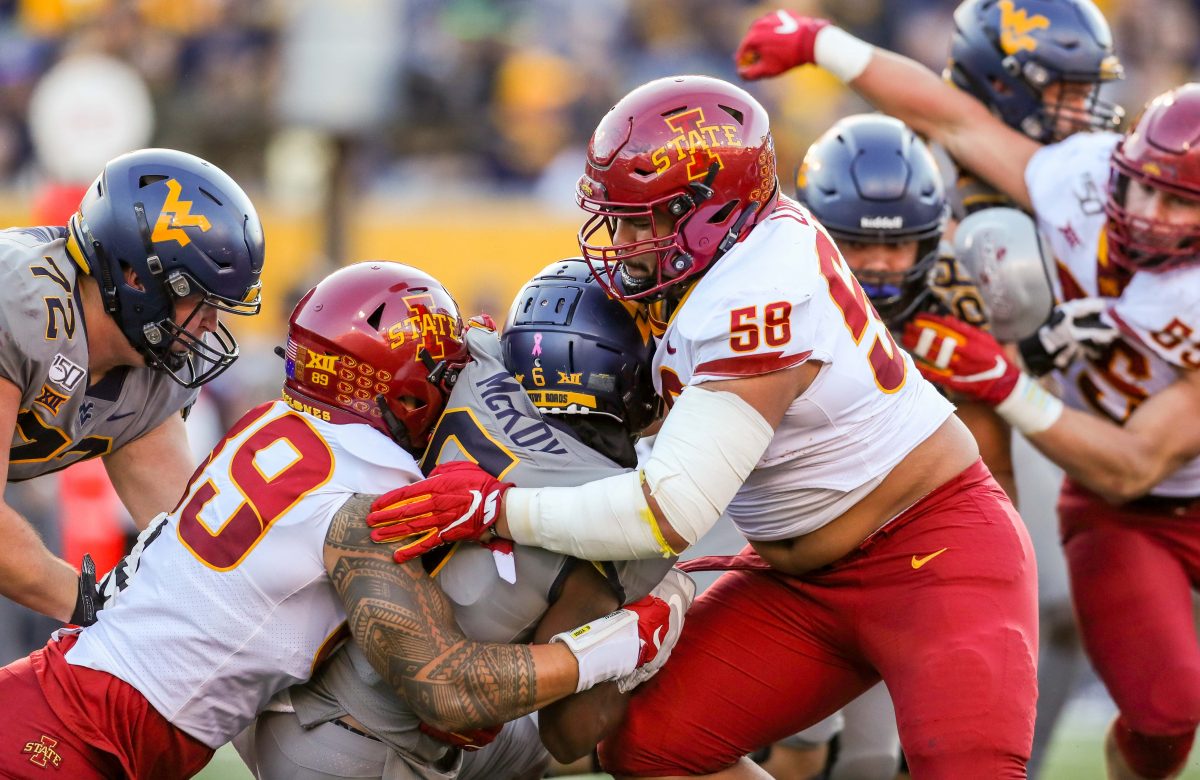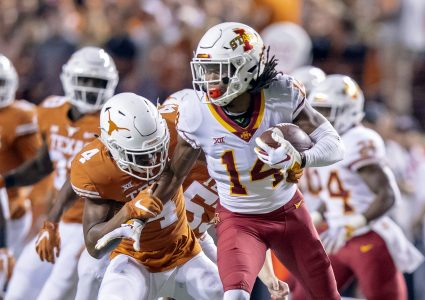Oct 12, 2019; Morgantown, WV, USA; Iowa State Cyclones defensive lineman Ray Lima (58) tackles West Virginia Mountaineers running back Kennedy McKoy (6) during the third quarter at Mountaineer Field at Milan Puskar Stadium. Mandatory Credit: Ben Queen-USA TODAY Sports
After a statistical dive into Iowa State’s third down defense, the shift turns to the field. Statistics indicated there were some issues which should manifest in an analysis of the on-field play.
I have chosen to look at a couple of examples indicative of the whole and only a couple of the issues. The plays described below apply to third down decisions, but also appeared on all downs and worked to create both a real and perceived vulnerability. The good news is that, much like the mantra from the 2019 season, the fix is attainable.
A Note About Personnel
A part of the third down answer – and the answer to the overall perception of defensive regression – was the quality and skillsets of the players tasked with executing the plays called within the scheme. A couple of points cannot be overlooked.
*** Cornerback: Brian Peavy and D’Andre Payne were experienced and disciplined players. Peavy was reliable and confident, if not dynamic, in coverage. Peavy was a solid cover man, controlled blitzer, and good tackler in the run game with positional flexibility. The defensive structure relies on the corner position to drive on the edges, play press at times, and force accurate throws by closing space deep.
2019 featured young Anthony Johnson and Datrone Young along with Tayvonn Kyle in the corner position. All were adjusting and had difficulty at times providing both positional discipline and tight spacing. Necessarily, this loosens coverage and compromises other portions of the structure. Therefore, the loss of the two experienced players caused a loosening of the defense that afforded opportunities for space to be created in both the run and pass game.
*** Defensive Line/Safety: The loss of JaQuan Bailey and the Greg Eisworth injury were harmful to third downs especially. Bailey represented a pass rush threat, even when rushing only three. Without him, Iowa State was forced to use less effective pressure packages. Eisworth was a key to pressure as well from the safety position (think he and Lewis v. WVU in 2018) but also provided disciplined coverage behind the pressure along with the two corners mentioned earlier. The varied replacements tasked with the same roles were less effective which I believe led to some of the key failures on third down.
Route Combos and Coverage Discipline
I have discussed at length that the delayed or outlet routes underneath the coverage is an issue for the current defensive scheme. It forces discipline in driving to tackle a receiver short of the line to gain. There were some players in depth roles who struggled mightily in this discipline. However, we also saw a slightly different approach to attacking the defense in the routes run by opponents.
The eight-man coverage, whether a true zone or with pattern match coverage is designed to compress the throwing windows for many route combinations. Where the routes drive to the mid-level and deep, they play into the strength of the coverage. However, when hi-lo concepts are used with lo-mesh and crossing routes, then coverage is subject to being stretched and pulled apart. This is what occurred.
Often there would be two deep receivers running influence routes with a fold inside (post or dig) and short crossing route. The crossing motion opened escape routes for QB runs and the folding routes exploit the short coverage which is pulled up by the short routes and the deep coverage which is extended by the vertical routes. Stretch it apart, threaten discipline with crossing motion, and create space to fold in beyond the market or escape with a run.
The play above is an example of this theory. In fact, I believe it originated with the 2018 Oklahoma game where they used the same concept to free deep receivers. Here it works under and across due to spacing and depth issues for Iowa State.
The inside receivers release deep and one folds off the screen in the deep middle. The outside receivers run mesh slide routes under to draw the coverage up and open the folding receiver or expose a deep route. It is 3rd and 16 and a chunk play is needed. The spy forces the throw short which is allowed to run for the first down because the LB’s have dropped their coverage beyond the line to gain thus compromising their ability to close early.
Fundamentals dictate guarding the line to gain. Discipline allows you to do it even with pressure behind you. But, guarding the line does not mean dropping too far behind the line to gain which creates an easier completion in front of the defense. If the LB is set at 14 instead of 19 the angle is reduced and that tackle is made around the 50 forcing a punt.
This is a good look at the point. The pass is incomplete, but should have been complete and we see the issue. Third and 2. The routes do not push deep but are all folding in. The cushion on the top of the screen is not explainable. The LB’s drop 3 yards behind the line to gain and are too deep to stop a quick first down pass. There was help over the top and the cover players have to stay and defend the line.
There is no yellow line on the field, but down and distance must be recognized on the field. This should be a dead play due to coverage discipline, not a drop. Too often, ISU displayed loose coverage on the underneath routes in third down situations. Note also that if the QB scrambled away from the route directions, then there is too much ground to cover to prevent a QB run for a first down.
These clips indicate the primary issue in Iowa State’s third down defense. Structural integrity in the context of down and distance is a must in playing solid defense. Iowa State has a solid defense, but this issue was a large part of the failures that vexed fan and team alike. Personnel is a part of it also, but the break down by being too deep and too loose is amplified on third down.

For context and confirmation, look at the picture above. Thank you broadcast for the illustration. Baylor ran the same basic defense that Iowa State did, they just did it better. Against Iowa State, they dropped 8 in pure zone on occasion. The three over defenders are more than adequate to catch deep routes. But, note the discipline of the under coverage. All are set two yards in front of the line to gain and creating tight windows for completions in front along with numbers to converge on the ball once completed. There is no drift even with a receiver putting pressure behind them. This is exactly how ISU played more often than not in years past and where a weakness developed in 2019.

Just so the problem is not thought to be isolated to ISU, see the above. Late in the game, Baylor shifted coverage to a looser, prevent style with the emphasis on closing off big plays. Iowa State’s route combination does not pull the coverage apart, instead Baylor plays soft with four deep. But, note that there remains a fairly tight window for the throw to be made and that there are five surrounding two. It takes a great throw to complete and there will be little run after the catch.
The Blitz Issue
There are two primary blitz looks that Iowa State used. The first is above. Slant the line and bring the safety and OLB off the edge. If the blitzers are split or stoned there is still plenty of coverage, but there is a weakness to the blitz side.
Here, there are a number of issues on third and long. The MLB is lazy in coverage and seems to bust getting bunched up underneath. The crosser wheels up on the scramble and there is too much separation from the safety who is too deep and the MLB bust.
OU and others handled this blitz look. It was handled often and teams were prepared for it and attacked it. If there is an oft used pressure package that is recognized, then Big 12 offenses are geared to exploit it. ISU needed to provide different pressure looks in 2019, but all too often utilized known blitz packages that were less effective and made more so by undisciplined coverage behind it.
This is the oft used Double A Gap blitz. It was effective at times against OU because it forced the play into a tighter half-field box which resulted in an ability to slow down the offense. It was effective in other games as well. Here, the safety looses his mind a bit and loses track of the most dangerous in coverage allowing an easy catch and run to a delay route (delay routes cause problems for this defensive scheme).
The point here is not that ISU can’t effectively get pressure with these two blitzes. Instead, if you are rewatching games, notice how often they are used and how effective they are. In my opinion, ISU needed a more creative pressure package in 2019 to counteract some of the familiarity teams would have with their innovative scheme. Instead, there was less creativity and less discipline in coverage which cost them in certain crucial situations.
Final Thoughts
Iowa State’s defense struggled in certain highlight spots during the 2019 season. A portion of that struggle was their opponents execution. But, a portion was personnel deficiencies, coverage discipline, and lack of pressure options. The defense is still good to very good.
As another season approaches (maybe), all of these issues can be shored up by returning and developing personnel, coverage adjustments complimentary to that development, and creation of some different looks when pressure is brought to bear. In fact, that is what the off-season is for.
I have little doubt that there will be a retrenching, but I do want to note that ISU’s third down efficiency has been consistent at 40-41%. An uptick in to the 30’s would be a very good sign for this team and indicate progress. But, they have shown to be very competitive and if they can just catch a few of the interception opportunities, it is likely perception will change.





